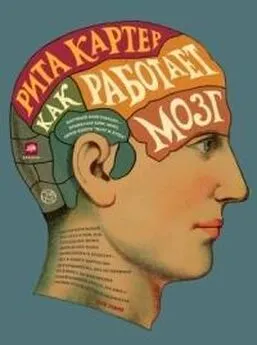Дин Бернетт - Счастливый мозг. Как работает мозг и откуда берется счастье
- Название:Счастливый мозг. Как работает мозг и откуда берется счастье
- Автор:
- Жанр:
- Издательство:Эксмо
- Год:2018
- Город:Москва
- ISBN:978-5-04-095041-6
- Рейтинг:
- Избранное:Добавить в избранное
-
Отзывы:
-
Ваша оценка:
Дин Бернетт - Счастливый мозг. Как работает мозг и откуда берется счастье краткое содержание
Счастливый мозг. Как работает мозг и откуда берется счастье - читать онлайн бесплатно ознакомительный отрывок
Интервал:
Закладка:
379
Roberts, P., Forbidden Thinking. 1995, Psychology Today: Psychology Today.
380
Johnson-Laird, P.N., Mental models and human reasoning. Proceedings of the National Academy of Sciences, 2010. 107 (43): p. 18243–18250.
381
Wegner, D.M., et al., Paradoxical effects of thought suppression. 1987, American Psychological Association: US. p. 5–13.
382
Mann, T. and A. Ward, Forbidden fruit: Does thinking about a prohibited food lead to its consumption? International Journal of Eating Disorders, 2001. 29 (3): p. 319–327.
383
Etchells, P.J., et al., Prospective Investigation of Video Game Use in Children and Subsequent Conduct Disorder and Depression Using Data from the Avon Longitudinal Study of Parents and Children. PLOS ONE, 2016. 11 (1): p. e0147732.
384
Burnett, D. Women and yogurt: what’s the connection? Brain Flapping 2013 2013–08–30; Available from: http://www.theguardian.com/science/brain-flapping/2013/aug/30/women-yogurt-connection-advertising.
385
Straus Jr, W.L. and A.J.E. Cave, Pathology and the posture of Neanderthal man. The Quarterly Review of Biology, 1957. 32 (4): p. 348–363.
386
Lee, M. Why Are Babies’ Heads So Large in Proportion to Their Body Sizes? 2017; Available from: http://www.livestrong.com/article/506251-why-are-babies-heads-so-large-in-proportion-to-their-body-sizes/.
387
Barras, C., The real reasons why childbirth is so painful and dangerous. 2016, BBC Earth: www.bbc.com.
388
Institute of, M., From Neurons to Neighborhoods: The Science of Early Childhood Development, ed. P. S. Jack and A. P. Deborah. 2000, Washington, DC: The National Academies Press.
389
Harlow, H.F., Love in infant monkeys. 1959: WH Freeman San Francisco.
390
Houston, S.M., M. M. Herting, and E. R. Sowell, The Neurobiology of Childhood Structural Brain Development: Conception Through Adulthood. Current topics in behavioral neurosciences, 2014. 16: p. 3–17.
391
Stafford, T., Why all babies love peekaboo. 2014, BBC_Future.
392
HarvardCenter. Five Numbers to Remember about Early Childhood Development – Center on the Developing Child at Harvard University. 2017; Available from: https://developingchild.harvard.edu/resources/five-numbers-to-remember-about-early-childhood-development/.
393
Dahl, R.E., Sleep and the Developing Brain. Sleep, 2007. 30 (9): p. 1079–1080.
394
Danese, A. and B.S. McEwen, Adverse childhood experiences, allostasis, allostatic load, and age-related disease. Physiology & Behavior, 2012. 106 (1): p. 29–39.
395
Shonkoff, J.P., et al., The lifelong effects of early childhood adversity and toxic stress. Pediatrics, 2012. 129 (1): p. e232-e246.
396
Avants, B., et al. Early childhood home environment predicts frontal and temporal cortical thickness in the young adult brain. in Society for Neuroscience annual meeting. 2012.
397
Jack, F., et al., Maternal Reminiscing Style During Early Childhood Predicts the Age of Adolescents’ Earliest Memories. Child Development, 2009. 80 (2): p. 496–505.
398
Brink, T.T., et al., The Role of Orbitofrontal Cortex in Processing Empathy Stories in 4- to 8-Year-Old Children. Frontiers in Psychology, 2011. 2: p. 80.
399
Neisser, U., et al., Intelligence: Knowns and unknowns. American psychologist, 1996. 51 (2): p. 77.
400
University of Oklahoma. Institute of Group, R. and M. Sherif, Intergroup conflict and cooperation: The Robbers Cave experiment. Vol. 10. 1961: University Book Exchange Norman, OK.
401
Galbally, M., et al., The role of oxytocin in mother-infant relations: a systematic review of human studies. Harv Rev Psychiatry, 2011. 19 (1): p. 1–14.
402
Wan, M.W., et al., The Neural Basis of Maternal Bonding. PLOS ONE, 2014. 9 (3): p. e88436.
403
Magon, N. and S. Kalra, The orgasmic history of oxytocin: Love, lust, and labor. Indian journal of endocrinology and metabolism, 2011. 15 (7): p. 156.
404
Noriuchi, M., Y. Kikuchi, and A. Senoo, The functional neuroanatomy of maternal love: mother’s response to infant’s attachment behaviors. Biol Psychiatry, 2008. 63 (4): p. 415–23.
405
Schore, A.N., Effects of a secure attachment relationship on right brain development, affect regulation, and infant mental health. Infant mental health journal, 2001. 22 (1‐2): p. 7–66.
406
Ainsworth, M.D.S., et al., Patterns of attachment: A psychological study of the strange situation. 2015: Psychology Press.
407
Wiseman, H., O. Mayseless, and R. Sharabany, Why are they lonely? Perceived quality of early relationships with parents, attachment, personality predispositions and loneliness in first-year university students. Personality and individual differences, 2006. 40 (2): p. 237–248.
408
Blustein, D.L., M. S. Prezioso, and D. P. Schultheiss, Attachment Theory and Career Development. The Counseling Psychologist, 1995. 23 (3): p. 416–432.
409
Potard, C., et al., The relationship between parental attachment and sexuality in early adolescence. International Journal of Adolescence and Youth, 2017. 22 (1): p. 47–56.
410
Baumrind, D., The influence of parenting style on adolescent competence and substance use. The Journal of Early Adolescence, 1991. 11 (1): p. 56–95.
411
Haycraft, E. and J. Blissett, Eating disorder symptoms and parenting styles. Appetite, 2010. 54 (1): p. 221–224.
412
Baumrind, D., Current patterns of parental authority. Developmental psychology, 1971. 4 (1p2): p. 1.
413
Foster, A.D. and M. R. Rosenzweig, Learning by doing and learning from others: Human capital and technical change in agriculture. Journal of political Economy, 1995. 103 (6): p. 1176–1209.
414
Landry, S.H., et al., Does early responsive parenting have a special importance for children’s development or is consistency across early childhood necessary? Developmental Psychology, 2001. 37 (3): p. 387–403.
415
Kaplowitz, P.B., et al., Earlier Onset of Puberty in Girls: Relation to Increased Body Mass Index and Race. Pediatrics, 2001. 108 (2): p. 347.
416
Neubauer, A.C. and A. Fink, Intelligence and neural efficiency: Measures of brain activation versus measures of functional connectivity in the brain. Intelligence, 2009. 37 (2): p. 223–229.
417
Santos, E. and C. A. Noggle, Synaptic Pruning, in Encyclopedia of Child Behavior and Development, S. Goldstein and J. A. Naglieri, Editors. 2011, Springer US: Boston, MA. p. 1464–1465.
418
Carskadon, M.A., Patterns of sleep and sleepiness in adolescents. Pediatrician, 1990. 17 (1): p. 5–12.
419
Owens, J.A., K. Belon, and P. Moss, Impact of delaying school start time on adolescent sleep, mood, and behavior. Archives of pediatrics & adolescent medicine, 2010. 164 (7): p. 608–614.
420
McClintock, M.K. and G. Herdt, Rethinking puberty: The development of sexual attraction. Current Directions in Psychological Science, 1996. 5 (6): p. 178–183.
421
Casey, B.J., R. M. Jones, and T. A. Hare, The Adolescent Brain. Annals of the New York Academy of Sciences, 2008. 1124 (1): p. 111–126.
422
Spear, L.P., The adolescent brain and age-related behavioral manifestations. Neurosci Biobehav Rev, 2000. 24 (4): p. 417–63.
423
Reyna, V.F. and F. Farley, Risk and Rationality in Adolescent Decision Making: Implications for Theory, Practice, and Public Policy. Psychol Sci Public Interest, 2006. 7 (1): p. 1–44.
424
Lenroot, R.K. and J. N. Giedd, Brain development in children and adolescents: insights from anatomical magnetic resonance imaging. Neuroscience & Biobehavioral Reviews, 2006. 30 (6): p. 718–729.
425
Henry, J.P., Biological basis of the stress response. Integrative physiological and behavioral science, 1992. 27 (1): p. 66–83.
426
Philpot, R.M. and L. Wecker, Dependence of adolescent novelty-seeking behavior on response phenotype and effects of apparatus scaling. Behav Neurosci, 2008. 122 (4): p. 861–75.
427
Walter, C., Last ape standing: the seven-million-year story of how and why we survived. 2013: Bloomsbury Publishing USA.
428
Weon, B.M. and J. H. Je, Theoretical estimation of maximum human lifespan. Biogerontology, 2009. 10 (1): p. 65–71.
429
Deng, W., J. B. Aimone, and F. H. Gage, New neurons and new memories: how does adult hippocampal neurogenesis affect learning and memory? Nature reviews. Neuroscience, 2010. 11 (5): p. 339–350.
430
Rakic, P., Neurogenesis in adult primate neocortex: an evaluation of the evidence. Nat Rev Neurosci, 2002. 3 (1): p. 65–71.
431
Shephard, E., G. M. Jackson, and M. J. Groom, Learning and altering behaviours by reinforcement: Neurocognitive differences between children and adults. Developmental Cognitive Neuroscience, 2014. 7: p. 94–105.
432
Nisbett, R.E., et al., Intelligence: new findings and theoretical developments. Am Psychol, 2012. 67 (2): p. 130–59.
433
Esch, T. and G. B. Stefano, The neurobiology of stress management. Neuro Endocrinol Lett, 2010. 31 (1): p. 19–39.
434
Goh, C. and M. Agius, The stress-vulnerability model how does stress impact on mental illness at the level of the brain and what are the consequences? Psychiatr Danub, 2010. 22 (2): p. 198–202.
435
Ulrich-Lai, Y.M., et al., Pleasurable behaviors reduce stress via brain reward pathways. Proceedings of the National Academy of Sciences of the United States of America, 2010. 107 (47): p. 20529–20534.
436
Milman, A., The Impact of Tourism and Travel Experience on Senior Travelers’ Psychological Well-Being. Journal of Travel Research, 1998. 37 (2): p. 166–170.
437
Glocker, M.L., et al., Baby Schema in Infant Faces Induces Cuteness Perception and Motivation for Caretaking in Adults. Ethology: formerly Zeitschrift fur Tierpsychologie, 2009. 115 (3): p. 257–263.
438
Brockwell, H., Why can’t I get sterilised in my 20s? | Holly Brockwell, in Contraception and Family planning. 2015, Guardian.
439
Feldman, S., Structure and consistency in public opinion: The role of core beliefs and values. American Journal of political science, 1988: p. 416–440.
Читать дальшеИнтервал:
Закладка:










